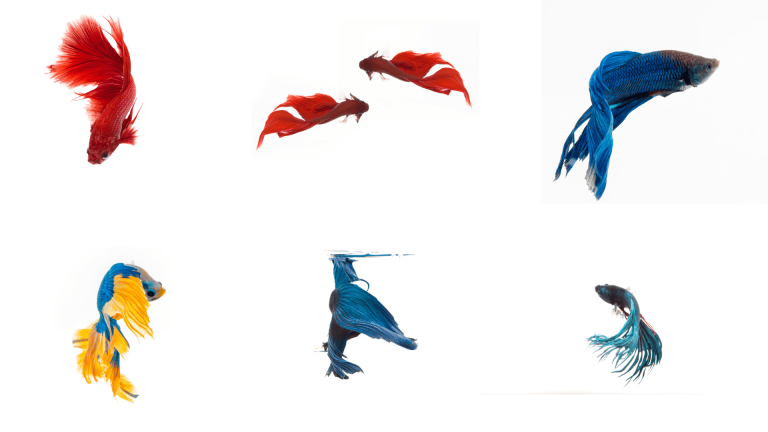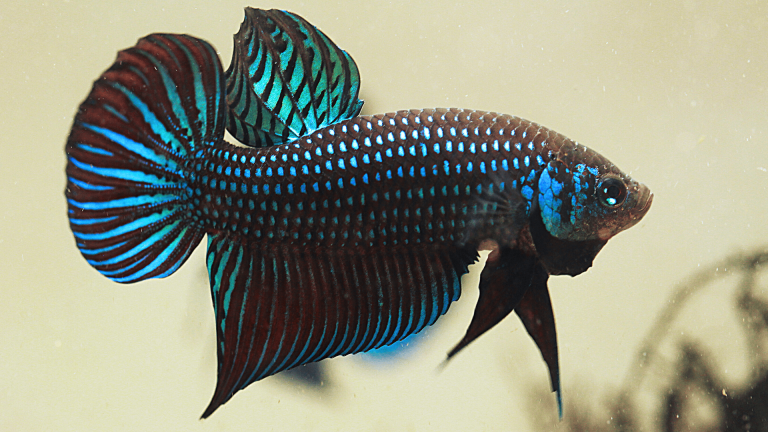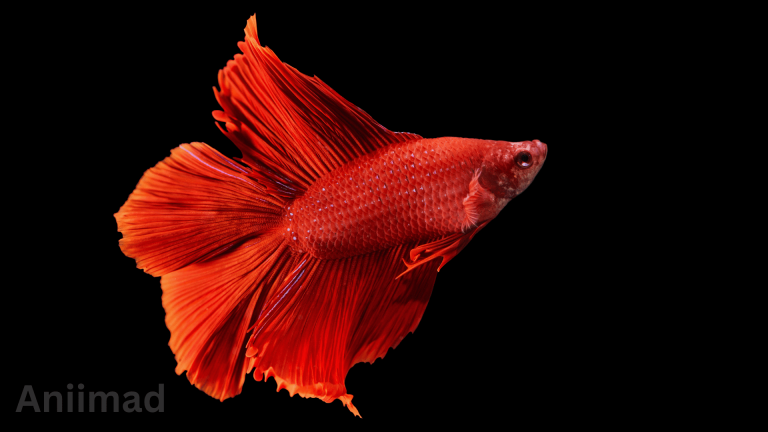Crown Tail Betta Fish: All You Need to Know
Crown tail betta fish, scientifically known as Betta splendens, is a mesmerizing creature that has captured the hearts of fish enthusiasts worldwide. With their stunning, elaborate fins resembling regal crowns, these fish make beautiful additions to any aquarium. This article will explore the world of crown tail betta fish, including their origins, unique characteristics, care requirements, and tips for showcasing their true beauty. So, let’s dive in and discover the allure of these magnificent aquatic creatures.
What Are Crown tail Betta Fish?

Crowntail betta fish, scientifically known as Betta splendens, is a popular and visually striking variety of domesticated freshwater fish. They belong to the gourami family (Osphronemidae) and are native to Southeast Asia’s rice paddies and slow-moving waters, particularly Thailand and Cambodia.
Their unique and captivating appearance sets crown tail bettas apart from other betta fish varieties. They characterize by their elaborate fins and have a comb-like or spiky edge. it gives their fins the formation of a regal crown, hence the name “crown tail.” The fins extend outwards and trail behind them, creating a mesmerizing display of flowing finnage.
The fins of crown tail bettas are more elongated and have more space between the rays than other betta fish. This distinctive feature enhances their elegance and beauty. The dorsal, anal, and ventral fins also have the crown tail pattern, albeit the caudal fin, or tail fin, is the most noticeable.
These fish exhibit vibrant colors, including red, blue, green, yellow, purple, and black. Some crown tail bettas have iridescent scales, which can change color depending on the lighting conditions. Their unique finnage and stunning colors make them highly sought after by aquarium enthusiasts.
Crowntail bettas are known for their territorial nature, which makes them a good choice for single-fish setups. Males, in particular, are known for their aggression towards other males, and housing them together can lead to fighting and injury. However, they can coexist peacefully with special tank mates, such as peaceful bottom-dwelling fish or snails. Researching and carefully selecting compatible tank mates is essential to keep your crown tail betta with other species.
Providing proper care and an ideal environment is essential for the health and well-being of crown tail bettas. They thrive in well-maintained aquariums with clean water, appropriate water parameters, and a balanced diet. Regular water changes, proper filtration, and a nutritious diet will help ensure their longevity and vibrant colors.
Overall, crown tail betta fish belove for their stunning appearance, graceful finnage, and captivating personalities. Whether you are an experienced fish keeper or a beginner, these magnificent creatures can bring beauty and life to your aquarium, making them a popular choice among fish enthusiasts.
Are Crown Tail Betta Fish Aggressive

Yes, crown tail betta fish, particularly the males, are known for their territorial and aggressive behavior. In their natural habitat, male bettas establish and defend their territories, which can be as small as a leaf or a small water area. They display aggressive behaviors towards other male bettas, especially when they perceive them as a threat or intruder.
When kept in captivity, it is essential to consider their aggressive tendencies and provide suitable housing arrangements. Housing multiple male bettas in the same tank do not recommend, as it often leads to aggressive encounters and can result in injury or death. The males may engage in fin-nipping, chasing, and fighting, which can harm their well-being.
If you plan to keep a male crown tail betta, keeping it in a solitary setup is best. Provide a tank with ample space for swimming and prominent hiding places, such as plants or decorations, to create territorial boundaries. If you wish to have multiple bettas in the same aquarium, consider keeping only a single male with compatible tank mates, such as peaceful bottom-dwelling fish or snails.
It is worth noting that while crown tail bettas can be aggressive towards other males, their behavior towards other fish species can vary. Some individuals may exhibit aggression towards other fish, particularly those with long-flowing fins or similar colors. It is vital to carefully research and select tank mates compatible with crown tail bettas to ensure a harmonious and stress-free environment.
Overall, understanding the aggressive nature of crown tail bettas is crucial for their well-being and the successful maintenance of an aquarium. You can help minimize stress and promote a healthy and enjoyable environment for your crown tail betta by providing them with appropriate living conditions and suitable tank mates.
What fish can I put with a crown tail, betta?
When considering tank mates for a crown tail betta fish, choosing species compatible with their territorial and aggressive nature is essential. While it generally recommends keeping a crown tail betta in a solitary setup, some peaceful fish species can coexist with them under certain conditions. Here are some potential tank mates to consider:
Peaceful Bottom-Dwelling Fish
Corydoras Catfish
These small, peaceful catfish are compatible with bettas as they occupy the bottom levels of the tank.
Kuhli Loaches
These eel-like fish are peaceful and spend most of their time burrowing in the substrate.
Otocinclus Catfish
Also known as “to cats,” they are peaceful algae eaters that can coexist with bettas.
Small Community Fish
Neon Tetras
These small, schooling fish are peaceful and can add color and activity to the aquarium.
Harlequin Rasboras
Peaceful and active, they are compatible with bettas in larger tanks.
Cherry Barbs
These colorful and vibrant fish can coexist with bettas but ensure a larger tank to minimize aggression.
Peaceful Mid to Upper-Level Swimmers
Ember Tetras
These tiny, peaceful fish are known for their vibrant red coloration.
White Cloud Mountain Minnows
These small, active fish are compatible with bettas in larger tanks.
Celestial Pearl Danios
Peaceful and visually striking, they can house with bettas in larger setups.
Remember, the key to successfully keeping tank mates with a crown tail betta is to carefully monitor their behavior and ensure adequate space, hiding places, and visual barriers within the aquarium. A backup plan and preparing to separate the betta is essential if aggression becomes an issue. Individual fish personalities can also vary, so what works for one betta may not work for another.
Always research each potential tank mate’s specific requirements and temperament, and be prepared to make necessary adjustments or changes. Keeping a well-maintained and adequately stocked aquarium will help ensure the well-being and compatibility of all the fish in your tank.
What is the Behavior of a Crown Tail Betta Fish?

Crowntail betta fish has a fascinating and complex set of behaviors. Understanding their behavior is critical to providing proper care and ensuring their well-being. Here are some typical behaviors exhibited by crown tail bettas:
Territoriality
Betta fish, including crown tails, are territorial creatures. They establish and defend their territories, ranging from small areas to more significant portions of the aquarium. Male crown tails, in particular, are highly territorial and will display aggressive behavior towards other male bettas or fish they perceive as a threat.
Aggression
Male crowntail bettas can be aggressive towards other males, especially if they share the same tank space. This aggression may include flaring their fins, spreading their gills, and displaying aggressive postures to intimidate rivals.
Displaying Finnage
One of crown tail bettas’ most captivating behaviors is their finnage display. They often flare their fins and gills to demonstrate dominance or to show off their beauty. This behavior is more pronounced when they encounter a perceived rival or during courtship displays.
Exploring and Investigating
Crowntail bettas are curious fish and will actively explore their surroundings. They enjoy investigating plants, decorations, and other objects in their environment. Providing hiding places and structures to study can keep them mentally stimulated and engaged.
Surface Breathing
Betta fish can breathe ambient oxygen thanks to a unique labyrinth organ. They can breathe air directly from the water’s surface to survive in oxygen-deprived conditions. You may often see them swimming to the water’s surface to take in gulps of air.
Building Bubble Nests
Male crowntail bettas are known to build bubble nests. These nests consist of bubbles created from saliva and used as a site for spawning. Building a bubble nest is a sign of male bettas’ readiness for breeding and can be an exciting behavior to observe.
Unique Personalities
Each crown tail betta fish has its distinct personality. Some may be more active and curious, while others may be more relaxed and prefer to stay in some regions of the tank. Observing their behaviors and patterns will help you understand their needs and preferences.
It’s important to note that crown tail bettas can exhibit aggressive behavior towards other fish and their reflection in mirrors or glass. Keeping bettas in tanks with reflective surfaces is not recommended, as they may become stressed or overly aggressive due to perceiving their reflection as a rival.
Understanding and respecting the natural behaviors of crown tail bettas will help you create an appropriate and stimulating environment for them. Providing enough space, suitable hiding spots, and a well-maintained tank will promote their overall well-being and allow them to exhibit their natural behaviors healthily.
How Do You Take Care of a Crown Tail Betta Fish?
Caring for a crown-tail betta fish involves providing them with a suitable environment, proper nutrition, and regular maintenance. Here are some essential care tips to ensure the well-being of your crown tail betta:
Aquarium Setup
- Tank size: Provide a tank of at least 5 gallons or larger. More space allows for better water quality and a swimming area.
- Water temperature: Maintain the water temperature between 78°F and 82°F (25°C and 28°C) using a reliable aquarium heater.
- Water quality: Use a filter to maintain water cleanliness and stability. Monitor and maintain appropriate ammonia, nitrite, and nitrate levels through regular water testing.
- Substrate and decorations: Choose a soft substrate, such as sand or fine gravel, to protect their delicate fins. Include plants, decorations, and hiding places to create a stimulating and secure environment.
- Lighting: Provide a suitable light source, ideally timed, to maintain a consistent day-night cycle.

Feeding and Nutrition
- Feed a high-quality betta-specific pellet or flake food as the staple diet. Look for a product formulated to meet betta fish’s nutritional needs.
- You can occasionally add frozen or live meals like brine shrimp, bloodworms, or daphnia to their diet. These provide additional nutrients and variety.
- Feed small portions of food multiple times daily, adjusting the quantity based on their appetite. Be careful not to overfeed, leading to health and water quality problems.
Water Maintenance
- Perform regular water changes of 20-30% weekly to maintain good water quality. Use a siphon or aquarium vacuum to remove debris and uneaten food from the substrate.
- Before adding tap water to the tank during water changes, use a water conditioner to eliminate chlorine and chloramine.
- Monitor water parameters such as temperature, pH, ammonia, nitrite, and nitrate levels regularly using appropriate test kits.
Observing Behavior and Health
- Spend time observing your crown tail betta fish daily to monitor their behavior, appetite, and overall well-being. Look for any signs of distress, disease, or unusual behavior.
- Look for signs of common betta health issues, such as fin rot, swim bladder disorders, or fungal infections. Address health concerns promptly by consulting a knowledgeable fish veterinarian or experienced aquarist.
Minimizing Stress
- Avoid abrupt temperature changes because they can stress your betta. Use a reliable heater to maintain a consistent temperature.
- Minimize loud noises and vibrations near the aquarium, as they can cause stress to your betta.
- Avoid placing bettas in aquariums with reflective surfaces, as they may perceive their reflection as a rival and become stressed or aggressive.
Remember, each crown tail betta fish is unique, and their care requirements may vary slightly. By providing them with a suitable environment, a balanced diet, and regular care, you can help ensure their health and well-being. Common observation and interaction will also strengthen the bond between you and your crown-tail betta fish.
Here are Some Frequently Asked Questions About Crown tail Betta Fish
What is a crown tail betta fish?
A crown-tail betta fish is a variety of domesticated freshwater fish belonging to the Betta splendens species. They are known for their elaborate, comb-like fins that resemble a crown.
How big do crown tail bettas grow?
On average, crown tail bettas grow to be around 2.5 to 3 inches (6 to 7.5 centimeters) in length. However, individual growth can vary depending on genetics, care, and diet.
How long do crown tail bettas live?
With proper care, crown tail bettas can live for 3 to 5 years. Some may even live longer, reaching six years or more.
Can crown tail betta fish keep with other fish?
Crown tail bettas are generally not recommended to keep with other bettas or fish of similar appearance. However, they can coexist with particular peaceful tank mates such as bottom-dwelling fish like Corydoras catfish or small schooling fish like neon tetras. Researching and carefully selecting compatible tank mates is essential to avoid aggression and stress.
How often should I feed my crown tail betta fish?
Feed your crown tail betta fish small portions of betta-specific pellet or flake food 2 to 3 times daily. It is essential to feed them appropriately as it can lead to health problems and water quality issues.
Do crown tail bettas need a heater?
Yes, crown tail bettas require a heater to maintain a stable water temperature between 78°F and 82°F (25°C and 28°C). A heater is essential for their well-being as they are tropical fish and need warm water to thrive.
Do crown tail bettas need a filter?
A filter in the aquarium is highly recommended for crown tail bettas. A filter helps maintain water quality by removing waste and providing better oxygenation. It also creates water movement, which bettas enjoy, simulating their natural habitat.
Can I breed crown tail bettas at home?
Yes, crown tail bettas can breed in a home aquarium. Breeding bettas require careful preparation, separate breeding tanks, and knowledge of the breeding process. It is advisable to research and learn about betta breeding before attempting it.
How can I tell if my crown tail betta fish is healthy?
Signs of a healthy crown tail betta include vibrant colors, vertical fins, active swimming, and a good appetite. Conversely, signs of potential health issues include fin damage, loss of appetite, abnormal behavior, or physical abnormalities. Observing and monitoring their behavior and appearance will help you detect potential health concerns.
Conclusion
Crown tail betta fish are fascinating and captivating creatures that bring beauty and elegance to any aquarium. Their unique comb-like fins and vibrant colors make them popular among fish enthusiasts. However, it’s essential to understand their specific care requirements to ensure their well-being.
Crowntail bettas are known for their territorial and aggressive nature, particularly among males. It is crucial to provide them with a suitable environment, ample space, hiding places, and compatible tank mates. Maintaining stable water conditions, proper nutrition, and regular observation are essential for their health and longevity.
By learning about their behavior, providing appropriate care, and creating an engaging environment, you can enjoy the beauty and personality of your crown tail betta fish. The bond you develop with your betta can be rewarding, and with proper care, they can live a happy and fulfilling life in your aquarium.





